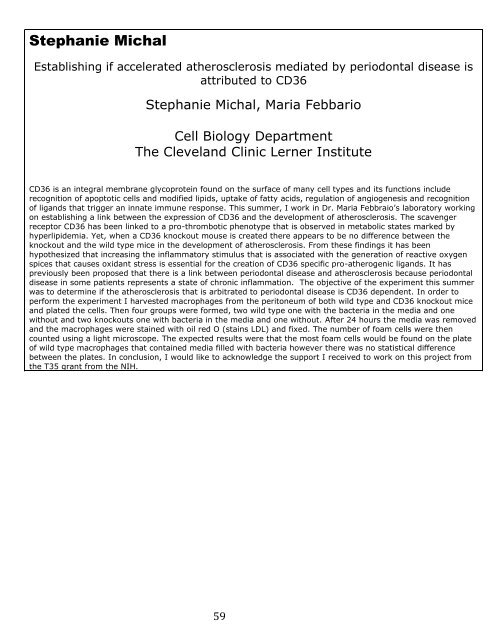student research day - Case Western Reserve University School of ...
student research day - Case Western Reserve University School of ...
student research day - Case Western Reserve University School of ...
You also want an ePaper? Increase the reach of your titles
YUMPU automatically turns print PDFs into web optimized ePapers that Google loves.
Stephanie Michal<br />
Establishing if accelerated atherosclerosis mediated by periodontal disease is<br />
attributed to CD36<br />
Stephanie Michal, Maria Febbario<br />
Cell Biology Department<br />
The Cleveland Clinic Lerner Institute<br />
CD36 is an integral membrane glycoprotein found on the surface <strong>of</strong> many cell types and its functions include<br />
recognition <strong>of</strong> apoptotic cells and modified lipids, uptake <strong>of</strong> fatty acids, regulation <strong>of</strong> angiogenesis and recognition<br />
<strong>of</strong> ligands that trigger an innate immune response. This summer, I work in Dr. Maria Febbraio’s laboratory working<br />
on establishing a link between the expression <strong>of</strong> CD36 and the development <strong>of</strong> atherosclerosis. The scavenger<br />
receptor CD36 has been linked to a pro-thrombotic phenotype that is observed in metabolic states marked by<br />
hyperlipidemia. Yet, when a CD36 knockout mouse is created there appears to be no difference between the<br />
knockout and the wild type mice in the development <strong>of</strong> atherosclerosis. From these findings it has been<br />
hypothesized that increasing the inflammatory stimulus that is associated with the generation <strong>of</strong> reactive oxygen<br />
spices that causes oxidant stress is essential for the creation <strong>of</strong> CD36 specific pro-atherogenic ligands. It has<br />
previously been proposed that there is a link between periodontal disease and atherosclerosis because periodontal<br />
disease in some patients represents a state <strong>of</strong> chronic inflammation. The objective <strong>of</strong> the experiment this summer<br />
was to determine if the atherosclerosis that is arbitrated to periodontal disease is CD36 dependent. In order to<br />
perform the experiment I harvested macrophages from the peritoneum <strong>of</strong> both wild type and CD36 knockout mice<br />
and plated the cells. Then four groups were formed, two wild type one with the bacteria in the media and one<br />
without and two knockouts one with bacteria in the media and one without. After 24 hours the media was removed<br />
and the macrophages were stained with oil red O (stains LDL) and fixed. The number <strong>of</strong> foam cells were then<br />
counted using a light microscope. The expected results were that the most foam cells would be found on the plate<br />
<strong>of</strong> wild type macrophages that contained media filled with bacteria however there was no statistical difference<br />
between the plates. In conclusion, I would like to acknowledge the support I received to work on this project from<br />
the T35 grant from the NIH.<br />
59
















